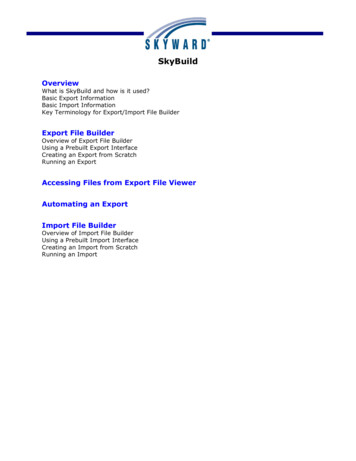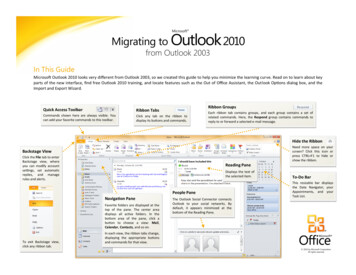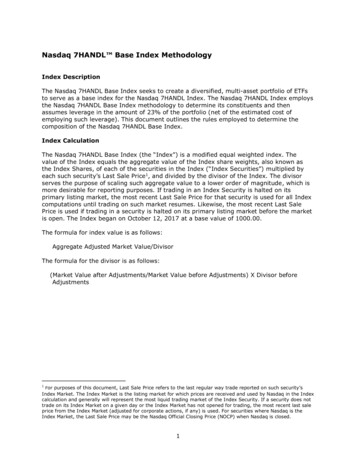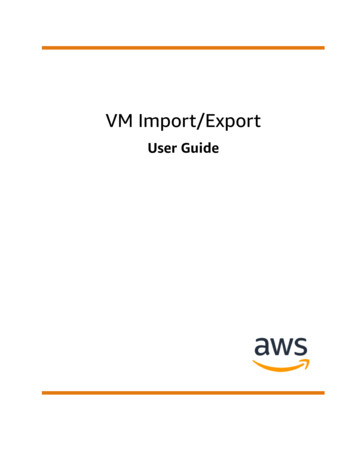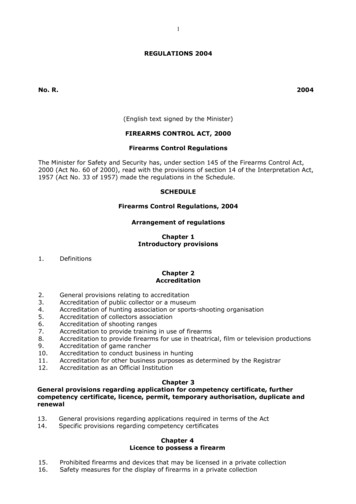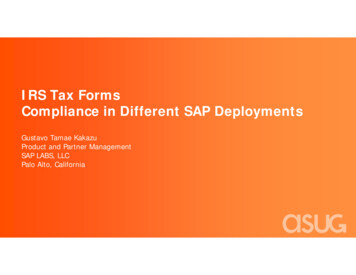
Transcription
1. A Summary of Export and Import Price IndexMethodologyA. Introduction1.1A price index is a summary measure of the proportionate, or percentage, changes in aset of prices over time. Export and Import Price Indices (XMPIs) measure the overall changein the prices of transactions in goods and services between the residents of an economicterritory and residents of the rest of the world. The prices of different goods and services alldo not change at the same rate. A price index thus summarizes their movement by averagingover them. A price index assumes a value of unity, or 100, in some reference period. Thevalues of the index for other periods of time show the average proportionate, or percentage,change in prices from the reference period.1.2Two basic questions are the focus of this Manual and the associated literature onprice indices: Exactly what sets of prices should be covered by the price index and how should they becollected?What is the most suitable way in which to average their movements?1.3The answer to the first question depends largely on the purposes of the index, whichdirectly connect with the domain of transactions the index is to cover. Distinct price indicesassociate with different domains of goods and services, such as household consumption,production, investment, and foreign trade flows. Export Price Indices (XPIs) measurechanges in the prices of the goods and services provided by the residents of a given economicterritory (usually, country) and used by nonresidents (that is, the rest of the world). ImportPrice Indices (MPIs) measure changes in the prices of goods and services provided bynonresidents (rest of the world) and used by residents of the economic territory. XPIs andMPIs, or XMPIs, are the primary concern of this XMPI Manual.1.4In developing a framework for understanding XMPIs, it is useful to consider theprinciples and practice of the Producer Price Index (PPI) as outlined in the PPI Manualpublished by the IMF in 2004. As with the PPI, we consider outputs produced byestablishments and intermediate consumption or inputs purchased by establishments. Bydefinition, an intermediate input for one establishment is the output of another establishment.From the resident establishments’ perspective, the XPI includes part of the domain of anoutput PPI, that is, the outputs sold by resident establishments to non-residents and the MPIincludes part of the domain of an input PPI, that is, the inputs purchased by residentestablishments from non-residents. However, unlike the PPI, XMPIs further include in theirdomain the outputs of goods and services purchased by, and inputs purchased from, the nonenterprise parts of its government, households, and nonprofit institutional units. Thisframework is from a resident unit’s perspective and will be seen later in this chapter to serveparticular analytical needs. However, XMPIs can also be constructed from a non-resident
unit’s perspective. Economists are interested in deflating changes in Gross Domestic Product(GDP) (expenditure estimate) over time and one component of this is exports minus imports.A weighted averages of the difference between XPIs and MPIs would serve this purpose.Exports and imports are defined in this context by the 1993 System of National Accounts,Rev. 1, from the rest of the world’s (non-resident’s) perspective: exports are uses of domesticproduction— input price indices—and imports are the rest of the world’s supply of goodsand services to resident users—output price indices. Both the resident’s and non-resident’sperspectives will be outlined as will their analytical uses and implication for measurement,especially with regard to valuation and economic theory.1.5Price indices preferably weight the price relative (change) of each specific item theycover by the value share of that item in the transactions domain of the index. For example, anXPI is a weighted average of the price relatives of its components where the weights are theshare of each component in the total value of exports covered by the index. Having collectedthe appropriate set of prices and, the weights, the second question concerns the choice offormula to average the price relatives. Alternative aggregation formulas are considered inChapters 2, 16–18, and 20–21 of this manual. The price relatives may take the form of ratiosof prices between the current and price reference period of specified representative itemswith detailed commodity descriptions, so that the prices of like are compared with like. Suchprice relatives can generally only be obtained from establishment surveys. However, unitvalues for commodity groups may be obtained from customs declarations and their ratiosused as “plug ins” for price relatives, a use considered in Chapter 2.1.6This chapter provides a general introduction to, and review of, the methods of XMPIcompilation. It provides a summary of the relevant theory and practice of index numbercompilation that helps reading and understanding the detailed chapters that follow, some ofwhich are inevitably quite technical. The chapter starts, as does the Manual, by distinguishingbetween XMPIs for which the price data are compiled primarily from establishment-surveydata and unit value indices that use unit value data from customs documentation as proxiesfor price data. It considers the merits of each and makes recommendations. The chaptercontinues to describe the various steps involved in XMPI compilation, starting with the basicconcepts, definitions, and purposes of XMPIs. It then discusses the sampling procedures andsurvey methods used to collect and process the price data, and finishes with the eventualcalculation and dissemination of the final indices.1.7An introductory presentation of XMPI methods starts with the basic concepts of anXPI and an MPI and the underlying index number theory. This includes the properties andbehavior of the various kinds of index numbers that compilers might use. Only after decidingon the most suitable type of index and its coverage based on these theoretical considerationsis it possible to go on to determine the best way in which to estimate the index in practice,taking account of the resources available. As noted in the Reader’s Guide, however, thedetailed presentation of the relevant index theory appears in later chapters of the Manualbecause the theory is technically complex when pursued in some depth. The exposition inthis chapter does not, therefore, follow the same order as the chapters in the Manual.1.8The main topics covered in this chapter are:
Uses of XMPIs;Unit value indices and price indices;Basic index number theory, including the axiomatic and economic approaches to XMPIs;Elementary price indices;Transactions, activities, and establishments covered by XMPIs;Collection and processing of the prices, including adjusting for quality change;Calculation of XMPIs;Potential errors and bias;Organization, management, and dissemination policy; andAn appendix providing an overview of the steps necessary for developing XMPIs.1.9It is not the purpose of this introduction to provide a comprehensive summary of theentire contents of the Manual. Thus, not all of the topics treated in the Manual are includedin this chapter. The objective of this general introduction is to give a summary presentationof the core issues with which readers need to be acquainted before tackling the detailedchapters that follow.B. The Uses of XMPIs1.10 The four principal types of price indices in the system of economic statistics—theconsumer price index (CPI), producer price index (PPI), and the XMPIs—are well knownand closely watched indicators of macroeconomic performance. They are direct indicators ofprice inflation for various flows of goods and services. As such, they are also used to deflateseries of nominal values of goods and services produced, consumed, and traded to providemeasures of changes in their volumes. Consequently, these indices are not only importanttools in the design and conduct of the monetary and fiscal policy of the government, but theyare also of great utility in informing economic decisions throughout the private sector. Theydo not, or should not, comprise merely a collection of unrelated price indicators, but provideinstead an integrated and consistent view of price developments pertaining to production,consumption, and international transactions in goods and services.1.11 Like other price indices in the system of price statistics, XMPIs serve multiplepurposes. Precisely how they are defined and constructed can very much depend on the datasource underlying their construction as well as by whom and for what they are meant to beused. XMPIs can measure either the average change in the price of goods and services asthey change ownership between residents of different economic territories, or when they aredocumented with export declarations or import tariff forms, as they cross national frontiers.1.12 Uses of XMPIs can be identified from a resident unit’s perspective. A monthly orquarterly XMPI with detailed commodity and industry data allows monitoring of short-termprice inflation for different types commodities (henceforth “commodities” refers to goodsand services) or through different stages of the resident producer’s production process.Measures of changes in the terms of trade of a country, determined as the ratio of the XPI tothe MPI, are used in the determination of changes in the real income of residents. Thenational accounts identify in the production accounts the output and intermediateconsumption (inputs) of resident establishments and these can be decomposed into the output
to residents and to the rest of the world (exports), and the inputs from residents and from therest of the world (imports). An analysis of the productivity of such establishments requiresvolume measures of such flows which in turn requires price deflators for exports andimports. In addition, the overall XMPIs for specific commodities can be used to adjust pricesof inputs in long-term purchase and sales contracts, a procedure known as “escalation.” Thusan analysis of the transmission of inflation, terms of trade, and productivity of residentestablishments, and use for escalation payments by them, is well served by XMPIs.1.13 Uses of XMPIs can also be identified from a nonresident unit’s perspective. Exportsand imports are defined by the 1993 System of National Accounts, Rev. 1 (1993 SNA Rev. 1),from the rest of the world’s (non-resident’s) perspective: exports are the rest of the world’suses of domestic production and imports are the rest of the world’s supply of goods andservices to resident users. Such definitions apply to exports and imports as components ofestimates of GDP by expenditure which comprises: household and government expenditure,capital formation, and net exports (exports minus imports) of goods and services. AlthoughXMPIs are an important economic indicator in their own right, a vital use of XMPIs is as adeflator of series of nominal values of exports and imports to derive volume estimates ofGDP by the expenditure approach. Thus if XMPIs are to be used as deflators a nonresidentunit’s perspective has to be taken and this, as will be seen below and in Chapters 4 and 18,has implications for valuation and economic theory, Beyond their use as deflators, thenational accounts framework for XMPIs provides insight into the interlinkages betweendifferent price measures. Through net exports, XMPIs directly affect the price index(deflator) of GDP by expenditure. The MPI also contributes to the price changes ofintermediate consumption by establishments, the input PPI; the CPI and householdconsumption deflator; the government consumption deflator; the capital formation deflator;and, through re-exports and goods for processing, the XPI. The XPI contributes to change inthe output PPI. As such, the detailed information in XMPIs allow compilers to show thecontributions of both the external and internal sources and uses of goods and services tochanges in each index of the system of price statistics. Since the price index (deflator) forGDP by the production approach (value added output – intermediate consumption) is afunction of the output and intermediate consumption PPIs, the export and import priceindices, viewed in this way, contribute to change in the price index (deflator), not only forGDP by expenditure, but also GDP by production.1.14 Any remaining part of exports involves the final uses of goods and services bynonresidents. An example is cross-border shopping by nonresident households, which isexports either as nonresident final consumption if the acquired items are consumer goods, oras capital formation if the acquired items are valuables, such as jewelry. Another example isacquisition of second hand productive assets by nonresidents for business purposes, which,besides being shown as exports, also enters as negative capital formation in the domestic,supplying economy, and as capital formation in the using economy.11It is possible, as well, for there to be a generally quite small part of imports not accounted for by nonresidentoutput involving direct change of ownership of second hand goods and valuables between households residentin different countries. This change of ownership counts as “negative consumption” (consumer durable goods) ornegative capital formation (valuables) in the supplying country or territory and positive consumption (consumer(continued)
1.15 Unlike the PPI, which involves only establishments, or the CPI, which involves onlyhouseholds, the XMPIs potentially involve all types of units in the world economy—not onlyestablishments, but also the nonbusiness parts of general government, households, andnonprofit institutions serving households—for transactions including: intermediate consumption and output by business units;capital formation via acquisition and sales of new and second hand nonfinancialassets by business units and households if the items transacted are valuables (e.g.,works of art and jewelry);final consumption of services (e.g., vacation accommodation), as well as of goods viaexchange of second hand consumer durables (e.g., automobiles), by non-businessparts of nonprofit institutions and government.1.16 This Manual adopts the System of National Accounts 1993 (1993 SNA) and theBalance of Payments Manual (BPM6) as comprising the conceptual framework for the valueaggregates underlying all macroeconomic statistics, including the XMPIs. The desirability ofthis conceptual concordance between the price indices permits users to clearly understand thelinkages between price series, discussed in more detail in Chapter 15. It is this concordancethat makes components of the XMPI useful as deflators for exports and imports in thenational accounts.1.17 These varied uses often increase the demand for XMPI data. For example, interest inthe XMPI as an indicator of externally generated inflation creates pressure to extend itscoverage to include more commodities. While many countries initially develop XMPIs tocover goods in international trade, the XMPIs can and should logically be extended to coverinternationally traded services, as noted in Chapters 3, 4, and 15.C. Unit value indices and price indices1.18 Export and import unit value indices are based on data from customs documentationand are so named because they take as their building blocks, for individual commodityclasses,2 the ratio of the unit value in the current to the base period. They measure, forindividual commodity classes, the change over time in the total value of shipments dividedby the corresponding total quantity. These elementary level unit value ratios—also, anddurables) or capital formation (valuables) in the using territory. Services imports must be provided bynonresident enterprises, and thus count as output of establishments rather than the negative consumption ornegative capital formation of nonresident households.2The classes used refer to the sub-headings of the Harmonized System which is a complete productclassification system designed as a “core” system so that countries adopting it could make further subdivisionsaccording to their particular tariff and statistical needs. At the international level, the Harmonized Systemconsists of approximately 5,000 article descriptions which appear as headings and subheadings. Countries canadd more detailed subdivisions for classifying goods for tariff, quota or statistical purposes so long as any suchsubdivision is added and coded at a level beyond the 6-digit numerical code provided in the HarmonizedSystem. Coding beyond the 6-digit level is usually at the 8-digit level and is generally referred to as the“national level,” see Chapter 4 for details.
hereafter, referred to as (elementary) unit value indices—are subsequently aggregated acrosscommodity classes using standard weighted index number formulas where the weights arethe relative shares of the commodity group in total exports/imports. Export and import priceindices have as their building blocks at the elementary level the price change of well-definedrepresentative items based on establishment surveys. Export and import unit value indices bynecessity differ from price indices because of their source data. A unit value elementaryindex, PU, is given for a price comparison between the current period t and a reference period0 over m 1, .,M items in period t and over n 1, .,N items in period 0 by: M t t pm qm(1.1) PU m 1M t qm m 1 N 0 0 pn qn n 1N 0 qn n 1 where prices and quantities are given respectively by pmt and qmt for period t, and pn0 and qn0for period 0.1.23 Unit value indices are used to represent price changes and the probity of their use isreliant on the homogeneity of the items transacted within the classification classes for whichtransactions are aggregated and the related issue of how tightly the classification classes arethemselves defined. Unit value indices work well for the aggregation of identical,homogeneous, items, but are biased for the aggregation of different, heterogeneous, goods.Consider, for example, the prices of two heterogeneous goods A and B at 10 and 12 in thereference period that remain constant over time, but with a shift in quantities from say 6, forboth A and B in the reference period, to 8 for A and 4 for B in the current period. The correctanswer for any price index number formula would give an answer of unity, no overall pricechange. However, the unit values would fall by 3 per cent reflecting the shift in the quantitybasket in the current period from the higher price level of 12 for A to the lower price level of10 for B. This unit value bias arise from a compositional shift in the basket of itemstransacted. Of note is that if A and B were homogeneous items, there would be no bias. Theunit value index would be the correct measure reflecting the fact that the same item hasbecome, on average, cheaper. The problem for XMPI compilers is that unit values fromcustoms documentation has the appeal of a relatively cheap and easily availableadministrative source of data, compared with pricing representative items fromestablishments, but the classification classes used are not sufficiently detailed to ensure thatthe prices of like in one month are compare with like in the next. Compositional changeswithin a classification group in the qualities of goods exported or imported from one monthto the next can change and unit value indices, as can be seen from equation (1.10), do not justmeasure pure price changes: they are influenced by changes in relative quantities.1.24 Customs data can usually be reliably used for information on the relative values ofgoods imported and exported to be used to weight the price changes. Data on the values ofgoods imported and exported measured in current prices do not suffer from unit value bias.Customs data may be supplemented with data from other sources for weights includingestablishment surveys (see Chapter 5). Customs documents can also be used in thedevelopment of a sampling frame of establishments using the details on the documents of theestablishments responsible for the trade (see Chapter 6).
C.1Unit value indices and their suitability for aggregation overhomogeneous items1.25 As explained previously, unit value indices are suitable, indeed they are ideal, for theaggregation of price changes of homogeneous items. They also solve the time aggregationproblem for identical items. Consider the case where the exact same item is sold at differentprices during the same period, say lower sales and higher prices in the first week of themonth and higher sales and lower prices in the last week of the month. The unit value for themonthly index solves the time aggregation problem and appropriately gives more weight tothe lower prices than the higher ones in the aggregate. Furthermore, if the elementary unitvalue index in equation (1.2) is used as a price index to deflate a corresponding change in thevalue, the result is a change in total quantity which is intuitively appropriate, i.e.M(1.2) p1m q1mm 1N p qn 10 0n n M 1 1 pm qm m 1M 1 qm m 1 N 0 0 pn qn n 1N 0 qn n 1 M qm 1N1m qn 10nNote that the summation of quantities in the top and bottom of the right-hand-side ofequation (1.2) must be of the exact same type of items for the expression to make sense—youcannot meaningfully add together quantities of different items.1.26 The 1993 SNA Rev.1 argues that if the price dispersion in a period was not due toquality differences—the homogeneous case—a unit value index should be used. Yet it notesan important exception regarding the case of institutionalized price discrimination. Ifdifferent importers of the same good or service, say electricity, face different prices and theindividual importers, say commercial customers and private households are unable to changefrom one price to another, then price indexes should be used. The constraint on theavailability to the purchaser of different prices must be institutional and not simply anincome constraint. This is because the household importers cannot substitute their purchasesfor electricity at the commercial rate. Thus for MPIs for identical items purchased bydifferent resident units or groups of units under institutionalized price discrimination, theimports for each unit or group should be treated as separate items and price indices compiledfor these items. For XPIs, the economic theory of producer price index numbers (ILO et al.,2004b, Chapters 17) defines for resident exporters a (fixed input) output price index as theratio of the two revenues in the periods compared, assuming fixed technologies and inputs.From the producer’s perspective, a shift in the quantities of identical items sold atdifferentiated prices effects a change in revenue from fixed inputs3—the institutionalarrangements matter and indeed were likely devised to enable revenue to be maximized. Theexports to the different countries for the identical good or service should not be treated asseparate items and unit values should be used. From the purchaser’s perspective it make nodifference to the ratio of expenditures for a, say, commercial customer if the producer shifts3We assume the costs of serving the different purchasers are not significantly different. Since exports, from aresident producer’s perspective, should be valued at basic prices, differential transport margins should not be aconsideration.
some of its quantities to private households—the institutional arrangements do not matter andunit values should not be used. In other words, from the viewpoints of the purchasers of theabove homogeneous commodity, what counts is his or her (separate from other purchasers)unit value price, not the overall unit value price across all purchasers, which would be therelevant price for the seller.1.27 Price comparisons may be required for aggregation across comparable, but notidentical, items, say electricity exported to different countries at different prices and pricechanges. It may be that the some of the price difference can be attributed to the reliability ofthe supply. If the effect of quality differences on price dispersion was small, unit values maybe used as long as the differential quality difference can be stripped from the prices, sayusing explicit estimate of the effect on price of the differences in supply quality. Qualityadjustments to prices are a standard part of index number work and Chapter 8 outlines themethods available to undertake such adjustments.C.2Errors and bias in the use of unit value indices1.28 Unit value indices derived from data collected by customs authorities are used bymany countries as surrogates for price changes at the elementary level of aggregation. Thefollowing are grounds upon which unit value indices can be deemed to be potentiallyunreliable: Bias arises from compositional changes in quantities and quality mix of what is exportedand imported. Even with best practice stratification the scope for reducing such bias islimited due to the sparse variable list—class of (quantity) size of the order and country oforigin/destination)—available on customs documents. Indeed it does not follow that suchbreakdowns are always beneficial;For unique and complex goods, model pricing can be used in establishment-basedsurveys where the respondent is asked to price each period a commodity, say a machinewith fixed specified characteristics. This possibility is not open to unit value indices;Methods for appropriately dealing with quality change, temporarily missing values, andseasonal goods can be employed with establishment-based surveys to an extent that is notpossible with unit value indices;The information on quantities in customs returns, and the related matter of choice of unitsin which the quantities are measured, has been found in practice in the past to beseriously problematic, though the advent of computer systems has been a majorinnovation in mitigating such problems—the Automated System for Customs Data(ASYCUDA) project4 of United Nations Conference on Trade and Development(UNCTAD)has applied computerized systems in the customs administrations of the leastdeveloped countries; 4ASYCUDA is functioning in about 90 developing countries. That system verifies declaration entriesimmediately. Declarations need to be completely filled in order to receive customs clearance. This meansamong others that quantity information is required. In addition, customs values are validated – to avoidundervaluation – using unit values on the declaration which are matched against a pre-determined list ofcommodity prices.
With customs unions countries may simply have limited or no intra-area trade data to use;An increasing proportion of trade is in services and by e-trade and not subject to customsdocumentation;Unit value indices rely to a large extent on outlier detection and deletion. Given thestickiness of many price changes, such deletions run the risk of missing the large pricecatch-ups when they take place and understating inflation;Valuation requirements for deflation of the aggregates of the United Nations (1993)System of National Accounts (SNA) are determined for unit value indices by customsprocedures which are not in accord with the accrual principle of the SNA 1993 REV.1.1.29 A main advantage of the use of unit value indices is held to be their coverage andrelatively low resource cost. However, such coverage should not be assumed for all classessince the unit values used may effectively be non-random samples and exclude: commoditiestraded irregularly; that have no quantity reported (especially for parts and machinery); havelow value shipments; and erratic month-to-month changes. The extent of such exclusionsmay be substantial,. Establishment-based surveys can be quite representative. Often a smallnumber of wholesalers or establishments are responsible for much of the total value ofimports or exports and, assuming cooperation, will be a cost-effective source of reliable data.Further, good sampling can, by definition, realize accurate price change measures. Finally,the value shares of exports and imports, obtained from customs data, which generally hasgood coverage of merchandise trade, will form the basis of the information used for weightsfor establishment-based price survey data.1.30 Alternative index number formula are usually assessed by determining how well theysatisfy a number of reasonable properties, the axiomatic approach. Chapters 17 and 21outline and apply such tests to compares the performance of a number of index numberformulas used at the higher and elementary level respectively. Unit value indices fail theidentity test—if all prices remain constant the value of the index should be unity—and theproportionality test—a proportional change in all prices should result in the sameproportional change in the index; both tests are regarded as important tests in index numbertheory. Unit value indices also fail the commensurability test—a price index should beinvariant to the units of measurement selected, for example, if the measurement of one ormore of the items changed from pounds weight to kilograms, the index should not change. Inpractice the units of measurement for an item in a detailed classification group are generallythe same for customs documentation, however, quality variations are equivalent to changes inunits of measurement, for example 20 automobiles are not equivalent to 20 automobiles withlarger engines, and in this sense failure of the commensurability test is an importantdeficiency of unit value indices derived from customs documentation.1.31 Alternative index number formula can also be assessed by the economic approach, asoutlined in Chapter 18. Chapter 2 also notes that an index that uses unit value changes as“plug ins” for pr
1. A Summary of Export and Import Price Index Methodology A. Introduction 1.1 A price index is a summary measure of the proportionate, or percentage, changes in a set of prices over time. Export and Import Price Indices (XMPIs) measure the overall change

